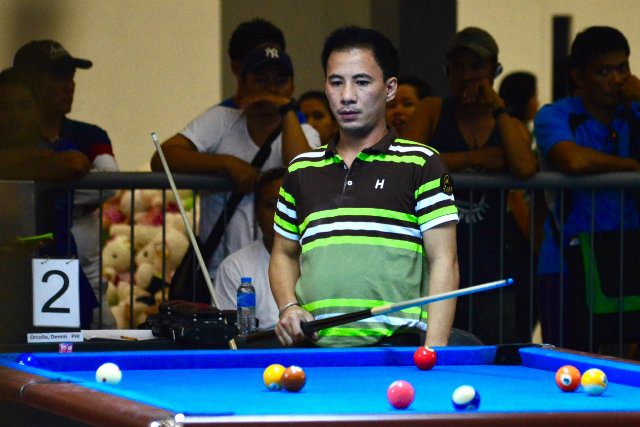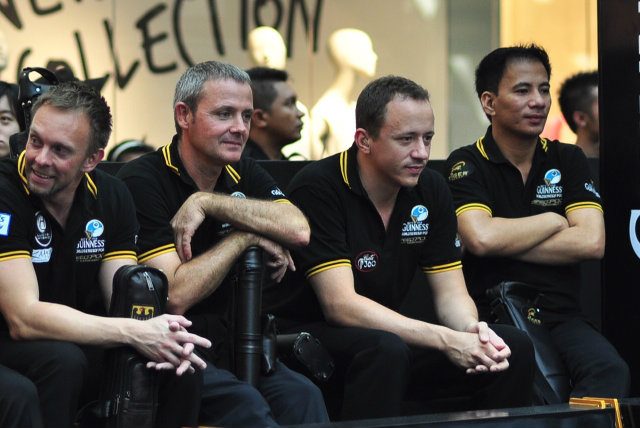SUMMARY
This is AI generated summarization, which may have errors. For context, always refer to the full article.

MANILA, Philippines – The World 9-Ball and 10-Ball Championships may have the glitzy titles, but for many in the pool world, the U.S. Open 9-Ball Championship is the big one.
First held in 1976, it has been played every autumn since then, something that can’t be said about the World 9-Ball and 10-Ball.
The tournament is traditionally staged in Chesapeake, Virginia, but has moved north on Interstate 464, across the Elizabeth River, to Norfolk. It’s been run since its inception by the colorful bon vivant Barry Behrmann. Last year it paid out $30,000 USD (P1,389,435) to the winner, with each of the 128 entrants shelling out an entry fee to play. This year the entry fee is $1,000 USD. (Most American pool tournaments are run like poker tournaments, with entry fee “buy-ins”, and sometimes even “re-buys” after you have been eliminated once.)
It’s a double-elimination event, with the undefeated champion on the winners’ bracket facing off against the best of the one-loss side in one match, a race-to-13 final.
Therefore it is not a “true double elimination” tournament, where the one-loss side winner must beat the undefeated player twice to lift the trophy, which incidentally, is shaped like the continental United States.
The Open has traditionally been winner’s break, instead of the more common alternate break.
With its history, prestige, and decent (for the world of pocket billiards) prize money, the U.S. Open is an important competition that every pool player wants to win. This year’s event runs from next Sunday, October 25 until October 30.
Despite the Philippines’ rich history in billiards, this tournament has also been marked by disappointment for Pinoy pool fans in recent years.
Efren Reyes became the first Filipino winner of the Open in 1994. He made the final in the next two years but lost to Americans Reed Pierce and Rodney Morris. Since then one top Pinoy player after another has been defeated at the final hurdle.
Alex Pagulayan has been the only other Pinoy to win the title, in 2005, 3 years after losing the final to Ralf Souquet. Ronnie Alcano has lost two finals, Amang Parica has lost two as well, and in last year’s final, Shane Van Boening defeated Dennis Orcollo 13-10. The year before he knocked out Lee Vann Corteza in the championship match. Rodolfo Luat is another Pinoy who fell short at the last test, losing the 2011 final to American John Schmidt.
So it’s true. Filipinos win tournaments all over the world, but in the U.S. Open, especially in final matches, we are positively snakebitten. But no doubt, Van Boening is the biggest reason these days.

The South Dakotan has won 4 Opens since 2007, including 3 of the last ones. He is hearing impaired, and wears a hearing aid and reads lips to get by. Maybe that’s his secret: he can’t hear his detractors. Or maybe there just aren’t any detractors anymore.
“Shane is 100% confident at the Open,” says Mike Howerton, who runs Azbilliards.com, one of the world’s best pool websites.
“I know he is the best American player and has been for years, but I am still surprised when he wins the Open every year. There are just too many talented players in that field to see the same player have that much success.”
Van Boening has a great all-around game, but one of his biggest assets has to be his break, which is crucial in the game of 9-Ball. Gone are the days of the howitzer breaks that were common in the 90s. Van Boening epitomizes the modern pool player’s approach: study the table, figure out its quirks, and rack and strike the diamond accordingly.
Yes, you read it right, rack accordingly. One of the U.S. Open’s quirks is that it’s a “rack your own” event, where you set the balls up yourself for the break. There is no referee to do it for you, even in the final match. Many pros thus become “mechanics,” the pool jargon for a player who is skilled in the art of setting up the rack to make a ball, usually the wing ball, go down off the break.
“There’s nothing really illegal about it,” adds Howerton. “They are playing within the rules.”
“He’s not cheating. He just knows how to break,” echoes pool commentator Jay Helfert. “Earl (Strickland) could do it in his prime.”
Making a ball on the break is one of the biggest advantages in pool, since skilled players can often run out easily when they stay on the table after breaking. Over the years a lot has been done to make this feat harder.
In the old days you racked with the wooden triangle, putting the one ball on the foot spot. The you took a swing at the one ball, trying to hit it full and making the cue squat in the middle. The wing ball went in too regularly that way, so they tried moving the pack closer, putting the 9 ball, the central ball in the back, on the foot spot. Players soon discovered that they could squirt the one ball into the side pockets with a cut break.
Tournaments have tried break boxes, where you must break from the center, and there have also been moves to disallow the soft break, which American pro Corey Deuel was a master of. Oftentimes tables just throw up repeatable boutique breaks that work in certain circumstances.
In the 2006 World 9-Ball Ronnie Alcano accidentally discovered a draw cut break that made the white ball go around 3 rails for perfect position on the one ball. He rode that break all the way to the title, defeating Ralf Souquet in the final at the Philippine International Convention Center.
There have also been efforts to make the racking more consistent with the use of implements like the Sardo Tight Rack, a racking device that used pressure for a tight pack. That has since gone out of favor.
Recently many tournaments have enforced a rule where 3 balls must now either be pocketed or cross the side pockets for the break to be legal. The intent is to take out the more predictable soft break. If a player commits an illegal break, control of the table passes to his opponent.
It’s not yet known if that rule will be in effect, but change is coming to this year’s Open in a big way.
The traditional wooden rack is out at the U.S. Open. In its place is the Accu-rack. You can see how it works below.
Instead of a triangle, the polyester template sits under the balls during the break and gets removed as the game goes on. The company that makes the template, Outsville.com, says you can get a tight rack, where the 9 does not move off the break, in 30 seconds. The U.S. Open this year will use an 18-inch-wide break box and the 9 ball will be spotted on the foot spot. As the video shows, the wing ball can only go into the corner pocket off a kiss, and the breaker’s only real hope is to get the one ball into the side.
More than one Filipino player has told me that they think this rack will help counter Van Boening’s advantage as a mechanic. They believe that without the wooden rack it will be harder for him to give himself an advantageous rack. The small break box may also help make an automatic ball-off-the-break impossible. Plenty of pool players believe that a break from the sides helps make balls.
So this Accu-rack could be a boon for the 8-man Philippine contingent for this year’s event. Orcollo is the top bet to win, but Warren Kiamco’s vast experience, (he has finished in the top 4 in the past), could tip things in his way. Corteza is also participating, as is former World 9-Ball runner-up Roberto Gomez. A real dark horse is new kid on the block Jeffrey Ignacio, whose classically Pinoy smooth, loose-gripped stroke and wristy cue action could have him really going places. Alex Pagulayan will try to win this tournament a decade after his last success here as well.
Carlo Biado, who finished runner-up to Ko Pin Yi in the World 10-Ball in General Santos City last February, is entered, as is Francisco Felicida, a Filipino based in Qatar.
But lurking in the entrant’s list this year is Ko, the best player in the game today. The Taiwanese ace not only won both the 10-Ball and 9-Ball world championships this year but he also teamed up with Chang Yu Lung to claim the World Cup of Pool for Chinese Taipei, a level of dominance almost unheard of.
Yet should the Pinoys get in stroke and benefit from a few lucky breaks, they could find some joy in Virginia starting next week. With the Accu-rack in place, they may have fewer excuses than ever before not to bring home the trophy. – Rappler.com
To watch the 40th U.S. Open 9 Ball Championship visit www.accu-stats.com for details on live streaming.
Follow Bob on Twitter @PassionateFaPH.
Add a comment
How does this make you feel?
There are no comments yet. Add your comment to start the conversation.